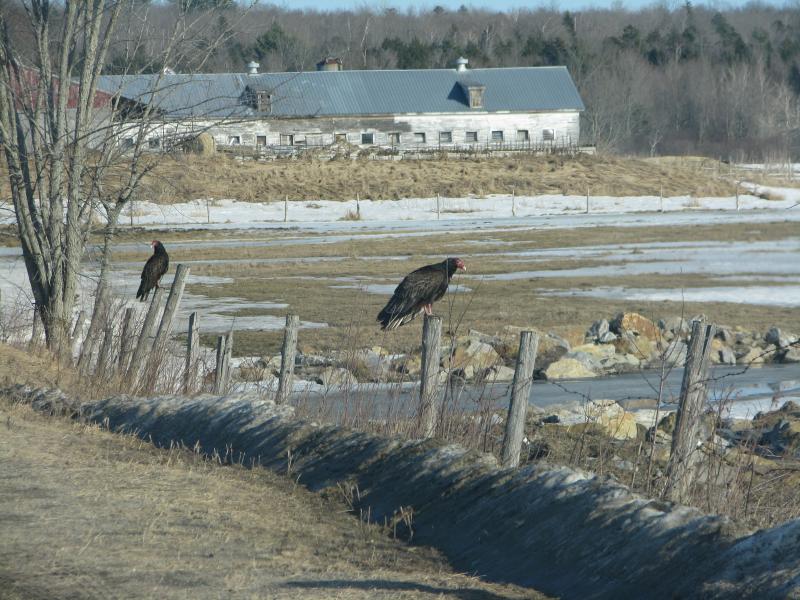While at a recent event, we met a wonderful family who, when they discovered our interest in all things avian, shared with us some of their bird stories. One of these was about finding, here in Maine, a turkey vulture nesting in an old barn. They told of how the adult birds and the nestlings would hiss if they came near and eventually would regurgitate a smelly, half-digested meal. All of this, probably quite obviously, is to attempt to drive off potential predators.
We have never had the good fortune of finding or seeing for ourselves a vulture nest despite seeing countless turkey vultures here in Maine over the years. One of our classic favorite natural history stories is called “An Adventure with a Turkey Vulture,” written by famed ornithologist George Miksch Sutton, about finding a turkey vulture nest as a boy in Texas. The nest was in a large, hollow log lying in a wet forest along a river. In the story, Sutton describes wriggling his whole body into the tight confines of the rotten log with arms outstretched in front of him and then discovering that he cannot move backward. He runs into more and more horrors as he is forced to try to squeeze his body through the log: “I found myself wondering how much more an imprisoned, half-suffocated, tortured boy, miles from home, could endure, when suddenly I realized that the mother vulture and I were not the only inhabitants of this hollow log.”
That’s when hundreds of daddy longlegs began running over his face and now half-naked body (his shirt had been ripped off as he squirmed through the log). Next he startled a nest of mice that also ran over and under him. Finally, he reached the mother vulture, who promptly regurgitated a wreaking, sticky mess that he had to continue crawling through to finally exit.
The story is worth a read if you can find it. You will find yourself feeling Sutton’s helpless, claustrophobic helpless terror.
While vultures do nest in hollow logs and small caves and crevices in cliffs and mountains, many now also take advantage of lofts and attics of old, little-used buildings. They typically lay two eggs that take a little over a month to hatch; incubation is handled by both male and female of the pair. The young birds take two months to reach the age when they can begin flying and leave the nest.
Turkey vultures are relatively new to Maine. In the 1950s, small numbers of the birds began appearing annually, though numbers did not begin increasing dramatically until the 1970s. The first breeding was confirmed in Camden in 1982. Given the numbers of turkey vultures that occur over much of Maine, we know that their have to be a strong number of nests around the state. But nesting turkey vultures are secretive enough that not many of the nests are ever found.
Our new friends have promised to show us the secret location of their vulture nest next year (we’ll be keeping the location a secret, of course, to protect our friends’—and the birds’—wishes). We’ll be excited to see it…as long as it does not involve crawling into a hollow log or other confined space!
Jeffrey V. Wells, Ph.D., is a Fellow of the Cornell Lab of Ornithology. Dr. Wells is one of the nation's leading bird experts and conservation biologists and author of “Birder’s Conservation Handbook”. His grandfather, the late John Chase, was a columnist for the Boothbay Register for many years. Allison, formerly of the Cornell Lab of Ornithology, is a senior director at the Natural Resources Council of Maine, a nonprofit membership organization working statewide to protect the nature of Maine. Both are widely published natural history writers and are the authors of the book, “Maine’s Favorite Birds” and “Birds of Aruba, Bonaire, and Curaçao: A Site and Field Guide” from Cornell Press.































